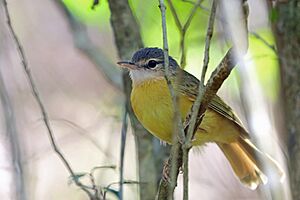Appert's tetraka facts for kids
Quick facts for kids Appert's tetraka |
|
|---|---|
 |
|
| Conservation status | |
| Scientific classification | |
| Genus: |
Xanthomixis (bird)
|
| Species: |
apperti
|
| Synonyms | |
|
Phyllastrephus apperti |
|
The Appert's tetraka (Xanthomixis apperti) is a small, special bird. It is a type of passerine bird, which means it's a perching bird. This bird is found only in the southwest of Madagascar. It was first officially discovered and described in 1972.
Contents
What Does Appert's Tetraka Look Like?
The Appert's tetraka is about 15 cm (5.9 in) long. That's about the length of a pen. It has a pink beak and gray legs. Both male and female birds look very similar.
- Its back, tail, and wings are green. The wings are a darker shade of green.
- Its head is gray.
- Its throat is white.
- Its sides and belly have an orange color.
- The very bottom parts of its body are white.
Where Does Appert's Tetraka Live?
This bird mostly lives on the ground in forests. It likes to stay in shrubs close to the ground. Appert's tetraka is currently found in only two places in southwest Madagascar:
- One place is the dry deciduous forest at Zombitse-Vohibasia National Park. This is where the bird was first found.
- The other place is a montane evergreen forest at Analavelona Classified Forest.
How Does Appert's Tetraka Live?
Appert's tetraka birds are very good at living on the ground. They search for insects under leaves and branches. They often do this in groups of up to eight birds. Sometimes, they even join other bird species while looking for food.
Why Is This Bird Special?
The Appert's tetraka is considered a vulnerable species. This means it could be in danger. It lives in a very small area, and its forest home is shrinking. People sometimes clear the forests for other uses.
- Good news: The Zombitse-Vohibasia forest is now part of conservation projects. These projects are helping to stop trees from being cut down.
- The Analavelona Classified Forest is not officially protected. However, it is in a remote area, so it is not in immediate danger right now.
Who Was Otto Appert?
The bird's common name and scientific name honor Reverend Otto Appert. He was a Swiss missionary who lived in Madagascar. He was also a naturalist, which means he studied nature.


